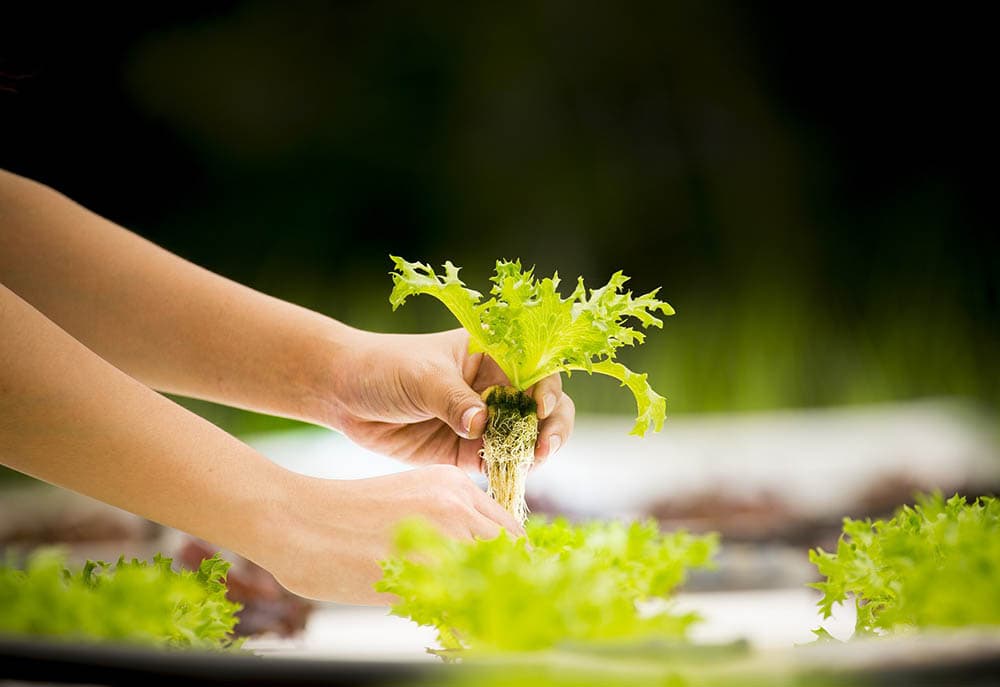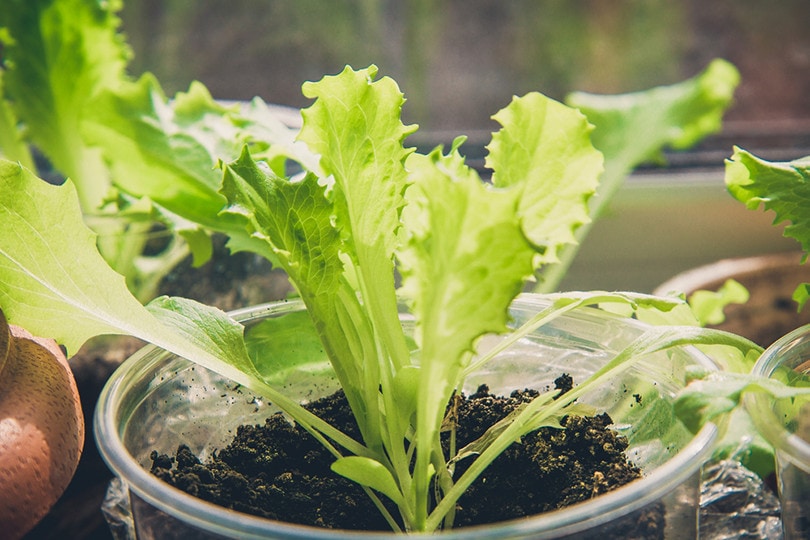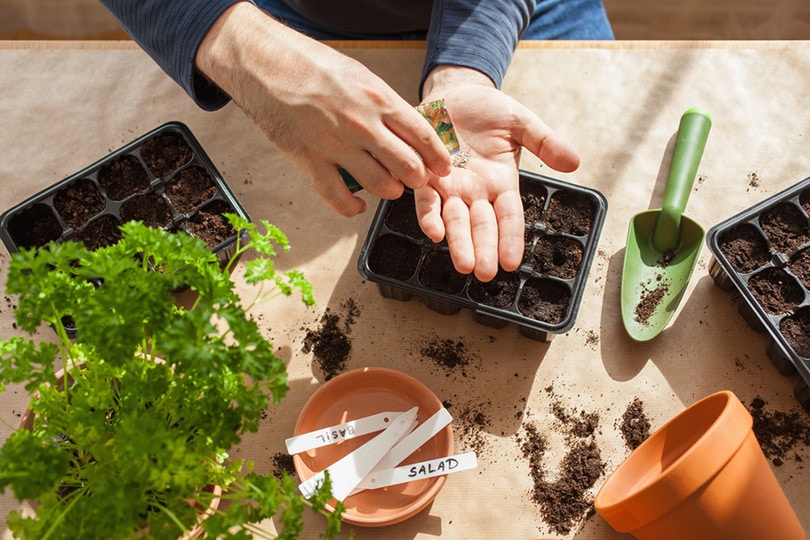Can You Grow Lettuce Indoors? Tips, Tricks & How-To Guide
-
Pete Ortiz
- Last updated:

It may not be the most flavorful vegetable out there, but lettuce is arguably one of the most essential. No salad would be complete without it, and a few leaves go a long way in justifying an otherwise unhealthy fast-food burger! With so many uses in daily meals, it makes perfect sense to include lettuce in your indoor garden!
Growing lettuce indoors allows anyone to keep this versatile green on hand at all times of the year. But while it fits seamlessly into a plethora of dishes, lettuce is at least slightly particular about its growing conditions. If you’re thinking about starting plants in your home, check out our guide to growing crisp, crunchy lettuce indoors.
Choosing a Location
The best spot for a lettuce plant is a window that receives up to 12 hours of sunlight. Lettuce needs at least 6–8 hours of direct sun, so a south-facing window is ideal. If you don’t have a window that can provide enough sunlight, you can also use LED or fluorescent grow lights. Position the lights about 6 inches above the plants, keeping them on for about 14 hours per day.
The optimal soil temperature for lettuce is 70°F–75°F, which aligns with the normal range of a climate-controlled home. Keep the container set away from any drafty spots, A/C vents, radiators, or appliances that give off heat, as they can dry out the soil and negatively impact the soil temperature. If you have pets in the house, make sure the plants are inaccessible.

Picking the Container
Lettuce plants don’t grow deep root systems, so you don’t have to be extremely picky about the container. Avoid terra cotta or any material that absorbs water as you risk drying out the plant. Clean plastic containers with drainage work best, but you should place them on a tray to collect water. If clay pots are all you have, line them with plastic bags to keep the moisture from exiting too quickly.
You can use starter trays to start your seeds. But once they begin growing, each plant needs up to 6 inches of space. Loose-leaf lettuces, such as Red Sails or Black Seeded Simpson, are easy to work with when growing in a single container. Head varieties, like romaine or iceberg, need at least 6 inches around them or individual pots.
Use containers in a place where you can easily rotate them. As plants develop and lean toward the sun, you may need to turn them on occasion to balance out the growth.
Growing Medium
For starting lettuce seeds, use a slightly acidic, soilless potting mix of peat moss, sand, and vermiculite. Once the plant sprouts and becomes large enough to move, plant it in well-drained potting soil. You can also continue using the soilless potting mix, but you may need to add extra fertilizer to keep the soil rich enough.
How to Grow Lettuce Indoors (Step-by-Step)

The simplest setup for growing lettuce indoors uses soil in containers, which is what we’ll detail here. If you want to grow lettuce on a larger scale, however, you can also consider hydroponics. A hydroponic growing kit will have everything you need to get started, though they can sometimes be expensive.
Grown from seed in a pot, many leaf lettuce varieties can reach maturity in about a month and a half, but you can start enjoying it much sooner. Head lettuce takes longer before you can harvest it, often about two months.
1. Sow Seeds
Moisten your starting mix and add about 3–4” to your container. Sprinkle a few seeds on the soil, keeping them about an inch apart, and cover them in a fine layer of potting mix no thicker than ⅛ inch. If you’re planting microgreens, you can plant them closer together, as they can grow in a dense cluster without battling for nutrients.
Position your container in your window and loosely cover it with plastic wrap to keep the humidity up. Add a nitrogen-rich liquid organic fertilizer to the soil when you plant your seeds.
At this stage, you must provide the equivalent of at least 14 hours of sunlight. Seeds germinate anywhere from 2–10 days if the soil is kept in the optimal 70°F–75°F range, but it can take up to 2 weeks in colder conditions.
Remove the plastic film when the lettuce seeds germinate. Thin or transplant the seedlings so they are 1–6” apart. Space them at least 6” apart if you’re growing head lettuce.
2. Water and Fertilize
Lettuce needs consistently moist soil, but that doesn’t mean it should be soaked. Spray the soil with water frequently to keep the fast-draining soil from drying out.
Monitor the top inch of soil daily for dampness and water it lightly as needed. You can water it from the bottom as well by placing the plastic container in a tray of water and letting the soil soak it up. For more convenience and efficiency, try a capillary mat, a self-watering system that consistently supplies a proper water level through a wicking action.
To maintain relatively high humidity levels, which lettuce enjoys, you can also place the plastic container over a tray filled with rocks and a little water. Evaporation will keep humidity in the ideal range of around 50%–70%.
If you don’t have any fertilizer in your potting soil, use a high-nitrogen food like deodorized fish emulsion once a week after planting, diluting it at about 1 tablespoon per gallon of water.
After each harvest, add a half-strength balanced fertilizer before beginning the next round. You can also use this fertilizer in place of the high-nitrogen food, adding some every few weeks to maintain nutrient levels. Because the soil drains well, it’s essential to replenish the nutrients regularly. Don’t let the fertilizer come into contact with the leaves, as it may cause the nitrogen to burn the plant.

3. Prune and Harvest
When lettuce reaches 4–5” in height, you can start harvesting it for use. You can cut off what you need and let the rest continue growing, cutting outer leaves off about an inch above the soil. Wash the leaves carefully to help remove harmful dirt, residue, and bacteria before use.
Prune back dead leaves as they pop up and watch for signs of bolting. In summer, when temperatures are high and days are long, conditions are right for lettuce to start flowering. Remove plants that begin growing flower stalks and adjust your growth strategy to maintain the proper heat and humidity.
To harvest a whole head of lettuce, cut it off an inch above the base. You can then leave the stump in the soil to grow another crop, or you can plant another round of seeds.
4. Storing Lettuce
Lettuce is perishable, so you’ll need to use it within 7–10 days after harvesting it. To store a whole head, wrap it in a damp paper towel after rinsing it, and put it in your crisper drawer or a plastic bag in the fridge.
If you’re storing lettuce leaves, spin them dry after rinsing and put them in a plastic container lined with paper towels. Rewash stored lettuce before you use it.
Conclusion
Lettuce is an incredibly versatile vegetable, and thankfully, it isn’t a challenge to grow. Set up a few plants inside, give them plenty of light, moisture, and nutrients, and you’ll be able to skip the trip to the grocery store the next time you need some leafy greens. By following this guide on growing your lettuce from seed, you’ll be sure to get the brightest, crispest, and most satisfying leaves possible.
Featured Image Credit: sippakorn, Pixabay
Contents



